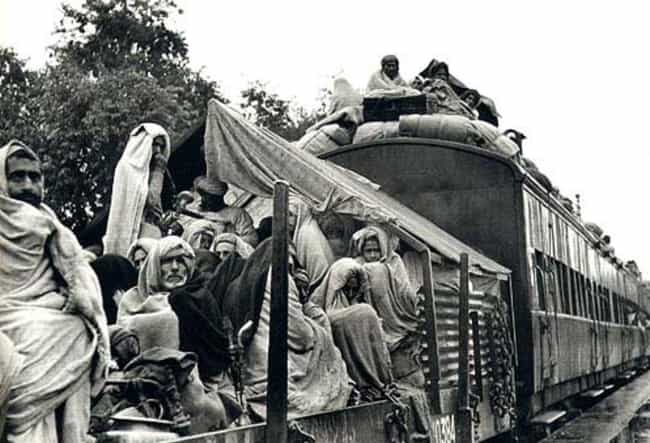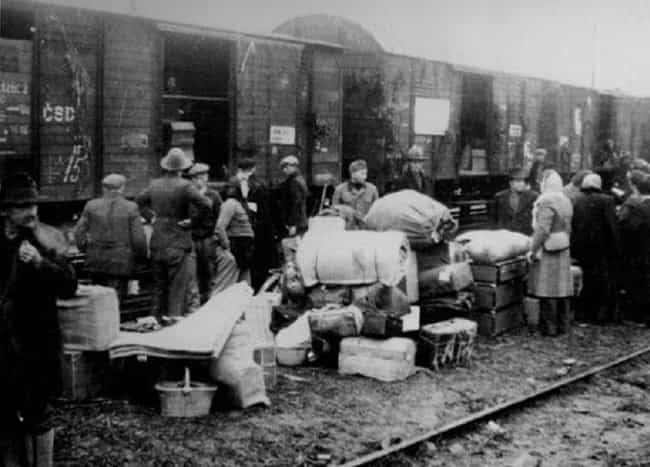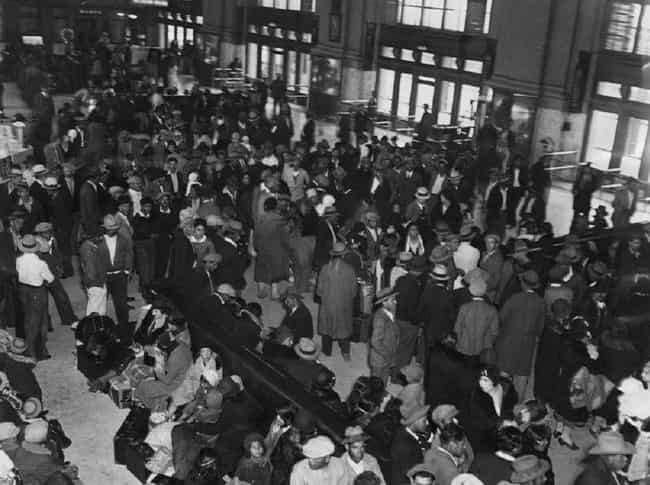
"The looming threat of Trump deportations are a worry for many inhabitants of the United States in 2017. The Orange President vowed to deport two to three million undocumented immigrants within the first few days of being elected. If, over the course of his time in office, he succeeds, it will be the biggest mass deportation in the nation’s history, and one of the biggest mass deportations in history.
In the early days of Trump's presidency, immigrant arrests and detentions increased by 38 percent compared to the same time the year before. However, deportations are down by a little over one percent, as fewer undocumented immigrants are crossing the US-Mexico border. As of 2017, it remains to be seen whether Trump will make good on his campaign promise. It behooves the public to remember Trump isn't the first US president or world leader to attempt a mass deportation.
What Trump, along with presidents Hoover and Eisenhower before him, aimed to do is externally deport Mexican-Americans. The world has a long history of mass deportations, which were carried out in a variety of ways and for a number of causes. In many cases, these deportations were accompanied by an extermination of groups being removed. This is a list of the most impactful and largest mass deportations in history.
The Partition Of India And Pakistan - Around 15 Million

As a final, brutal middle finger to the Indian subcontinent, the British government partitioned the region into two separate nations when colonial rule ended in 1947: India and Pakistan. Hindus and Muslims were instantly pitted against each other; the latter formed the majority in Pakistan, the former did so in India.
The division led to one of the greatest human migrations in history. Around 15 million people fled their homes as widespread violence between the two religious groups claimed the lives of around one million people.
While the mass movement of people across the borders of India and Pakistan is typically desribed as a migration, it occurred as a result parties beyond local control creating an environment of hostility and violence that essentially forced large portions of the population to leave ancestral homelands to remote parts of the subcontinent to avoid persecution, harassment, beatings, and death. The British government inadvertantly presented tens of millions of people with an ultimatum - leave, or suffer and maybe die.
The Final Solution - Between 6 And 9 Million

The Holocaust was a massive deportation of Jews and other ethnic groups to death and hard labor camps primarily located in Poland. Like many of the other deportations on this list, Hitler’s “Final Solution” was a plan to remove unwanted peoples from Germany and other occupied nations. Between 1942 and the end of World War II, millions of Jews were deported, six million of whom were systematically murdered under orders from the Nazi high command.
Soviet Era Deportations - Around 6 Million

Under Joseph Stalin, the Soviet Union ordered massive internal deportations and executions of millions. This began in the 1930s, when Stalin ordered the deportation of dozens of ethnic groups as punishment for their perceived political leanings. These included Chechens in the Caucasus region, Volga region Germans, Kurds, and Crimean Tatars. Stalin moved these groups away from the front to areas deep within the Soviet Union, like Siberia.
The deportation of Chechen people is considered genocide; it's estimated some 30% of the population died in the four years following the deportation. Throughout the ‘40s, the deportations continued in places like the Baltic States; more than 57,000 Latvians were deported or sent to the Gulags. In 1941, 10,000 Estonians were deported; the men were sent to the Gulags.
In 1944, Stalin ordered the deportation of the Crimean peninsula. More than 230,000 Crimean Tatars were deported, primarily to Uzbekistan. Nearly half of those deportees died between 1944 and 1947. It's estimated a total of six million people were internally deported from ancestral homelands to remote parts of the Soviet Union.
Mexican Repatriation In The 1930s - Around 2 Million

Before Trump’s election promise to deport millions of Mexicans from the United States, President Herbert Hoover succeeded in expelling about two million Mexican Americans in the early 1930s. This mass deportation became known as Mexican Repatriation, and remains a blight on America's history. What’s even more disturbing is that more than half of those expelled were American citizens, born in the United States.
During the Great Depression, there was a growing sentiment among white Americans that Mexicans were taking jobs and resources away from “true” citizens, a sentiment that is disturbingly echoed in the 21st century. Many believed that even though the majority of these Mexicans were citizens, a true American citizen had to be white. There were major roundups of Mexican workers in workplaces and in public. This massive deportation tore apart families and placed many Mexican- American citizens in a country in which they’d never even stepped foot.
Operation Wetback - 1.1 Million

In 1954, barely 20 years after the Mexican Repatriation, President Eisenhower oversaw the deportation of an estimated 1.1 million undocumented Mexican immigrants. Trump referred to Eisenhower’s “Operation Wetback” as a success during his campaign.
"The Eisenhower mass deportation policy was tragic," said Alfonso Aguilar, of the American Principles Project’s Latino Partnership.
"Human rights were violated. People were removed to distant locations without food and water. There were many deaths, unnecessary deaths. Sometimes even US citizens of Hispanic origin, of Mexican origin were removed. It was a travesty. It was terrible. Immigrants were humiliated. So, to say it's a success story is ridiculous. It shows that Mr. Trump doesn't know what he's talking about."
Expulsion Of The Moriscos - About 500,000

About a century after tossing out the Jews, the Spanish decided to eliminate the Muslim population as well. King Phillip III signed a decree in 1609 to expel all the “Moriscos”- a derogatory term meaning “little Moors,” and used to describe the descendants of Spain’s Muslim population – from Spain. The Moors were given three days to pack their belongings and board ships heading for North Africa or the Ottoman Empire. By 1614, every Moor descendant was gone, and Islam disappeared from the Iberian Peninsula. The Spanish Muslim population went from 500,000 to zero within 100 years. The expulsion of the “moriscos” was considered a Holocaust.
Despite the violent deportation, Moors had a lasting effect on Spanish culture, especially in Andalucía. Flamenco music has distinguishable Arab roots, as does much of the architecture throughout southern Spain, the Alhambra being a prime example.
Spanish Expulsion Of The Jews - About 200,000

The year 1492 was infamously portentous for the indigenous people of the western hemisphere, though also a very bad one for Jewish residents of Spain. As Christoper Columbus wrote in his diary:
“In the same month in which their Majesties [Ferdinand and Isabella] issued the edict that all Jews should be driven out of the kingdom and its territories, in the same month they gave me the order to undertake with sufficient men my expedition of discovery to the Indies.”
Spanish Jews either had to convert to Catholicism or leave the country under Isabella’s Alhambra Decree. Some 200,000 Jews are thought to have been forced out of Spain, many of whom ended up in North Africa, Turkey, Italy and the Netherlands.
As of 2014, Spain offers reparations to the descendants of Jews expelled from country: anyone who can trace ancestry to Sephardic Jews is granted Spanish citizenship.
British Deportation Of Criminals And Dissenters To Australia - Approximately 162,000

In 18th century England, overpopulation and job scarcity drove the crime rate through the roof. Prisons were overrun and convicts were dying at alarming rates. Until 1782, England sent excess prisoners to colonies in the Americas. When the American Revolutionary War ended in 1783, the newly independent nation no longer accepted prisoners from its former oppressor.
So, the British began sending convicts to penal colonies in Australia. In 1788, the first convicts were deported from England to Botany Bay. The last shipment occurred in 1868; in total, approximately 162,000 men prisoners were deported to Australia.
Hungarian Deportations To Czech Lands - Around 120,000

After WWII, the Czechoslovakian government devised a plan to deport the Germans and Hungarians living within their borders. For much of the war, Hungary was an ally of Germany, which explains Czechoslovakia’s negative sentiment towards these two nations, which were branded trouble makers and war criminals.
The Czechoslovakian’s government asserted it could not move to a peaceful future with Germans and Hungarians living in the nation. But the Western powers that won the war were not too keen on the term “deportation"; “population exchange” proved more palatable, as masses of people moved in both directions. Around 120,000 Hungarians were deported from Czechoslovakia to Hungary, while almost 74,000 Slovaks willingly resettled in Czechoslovakia.
Roman And Persian Empire Era Deportations - Approximately 70,000

The Battle of Edessa, fought in the ancient Macedonian city of Edessa, which sits along the contemporary border of Turkey and Syria, was one of the most crushing defeats in Roman military history. It was the first time a Roman Emperor was captured in battle. Around 290 CE, the Romans, led by Emperor Valerian, aimed to crush the Sassanid Empire, led by Shapur I, and send its forces back to Asia minor.
The Sassanid Empire was the second dynasty to rule Persia (modern day Iran). Shapur described how Valerian marched against him with an army of 70,000 men. Shupur’s inscription on the Ka'ba-ye Zartosht at the Naqsh-e Rustam necroplis in Iran reads:
“We fought a great battle with Valerian, and we captured the emperor Valerian with our own hands and the others, the praetorian prefect and senators and officials, all those who were the leaders of that force, and we made all of them prisoners and deported them to Persis."
That is a ma, if Shapur’s accounts are to be believed. They were sent to Persis and other areas in modern-day Iran, hundreds, if not more than 1,000, miles away. These deportations lead to Roman soldiers founding Persian cities and the spread of Christianity throughout the Sasanian empire.
Babylonian Exile - About 40,000

Jews have a long history of being exiled, expelled, and deported. The Jewish Diaspora is thought to have begun in 597 BCE, when King Nebuchadnezzar of the Chaldeans conquered Jerusalem. Following Nebuchadnezzar's arrival, there were three massive deportations of inhabitants of the Kingdom of Judah to Babylon. The total numbers of those deported are contested by historians, but it’s thought to be in the tens of thousands.
Deportations began with Judah’s most prominent citizens, including King Jeconiah, to Babylon. In 538 BCE, Persian King Cyrus the Great conquered Babylon and allowed the Jewish deportees to return to Judah. He also reconstructed the Temple of Solomon that was destroyed by Nebuchadnezzar. Some 40,000 Judeans were said to have returned, as noted in the Book of Ezra. But not all Judeans returned, marking the beginning of their Diaspora.
Expulsion of the Acadians - About 11,500

During the French and Indian War, the British deported some 11,500 Acadians from modern day Canada’s maritime provinces: Nova Scotia, Prince Edward Island, and New Brunswick. The Acadians were the descendants of French Colonists who settled in those parts of Canada. Even when their land was taken by the British after 1713, the Acadians were granted relative autonomy. But Britain grew suspicious of rebellion after the Acadians refused to sign an oath of allegiance to the crown.
In what became known as the Great Upheaval or Great Expulsion, under orders from governor Charles Lawrence, British soldiers pillaged Arcadian land, burning farms and crops. Thousands were shipped off to various English colonies throughout modern-day America, while others landed in France and the Caribbean. Thousands died on the voyage, in overcrowded, disease-ridden ships.
Acadians were not sent to Louisiana, though many were attracted to the place because of their familiarity with the language. Those who ended up there helped develop Cajun culture. They were allowed to return to Acadia in 1764.
King Edward I Expelled 2,000 Jews From England

In 1290, King Edward I of England passed a decree banishing Jews from England for more than 350 years. The Edict of Expulsion resulted in the deportation of around 2,000 Jews. This measure was met with little resistance by the public, as it was partly the result of rising anti-Semitism across England. It was also due to King Edward’s critical financial situation. He got himself into major debt and imposed a hefty tax on the people of England. He figured more people would be accepting of the tax if he promised to expel the Jews."
History's Biggest Mass Deportations and What the Consequences Were

No comments:
Post a Comment